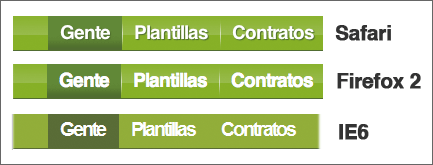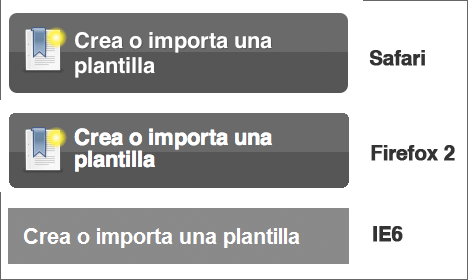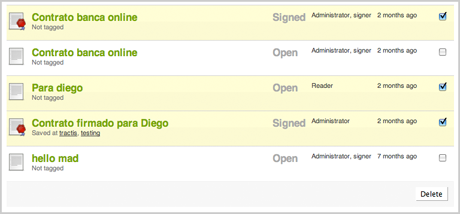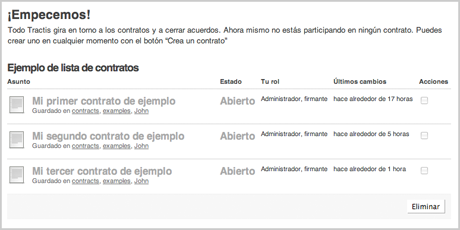The new Tractis start page
We have a new start page! After two intensive weeks, we have finally launched the new way to enter and get to know Tractis. Each week we have improved every aspect of the application and I have to bite my tongue so I don’t tell what’s coming.
How it all started
When we first started out with Tractis, we had a start page similar to the one we have now. When I say similar, I mean that it had the same organisation of data as it has now: start session, tour etc.
At that time, Tractis was a closed project, only open to a group of beta testers who could invite anyone to join them. It was a start page a bit like a trailer of what would come later in August 2007. Our application, which was growing, had a darker look and feel than the current one and was the best we could do to invite people to discover Tractis back then, given that the number of DNIe (Spanish electronic ID) cards was low in Spain.
But later came the launch of the site in version 1.0. Tractis stopped being a beta, closed to the public and we began to offer the possibility of registration. We totally refactored the application; new sections, new conventions, new graphical style etc. We opened the application to everyone so that they could discover Tractis. We made the most of our knowledge, out standard way of programming so that Google would bring us an immense quantity of visitors who who register and use our application, mostly to share templates.
While the number of visitors rose considerably, it produced collateral damage which we identified: people began to think that Tractis was a site just for sharing templates. This is really untrue: we specialise in digital signature and, in addition, integration of digital signature and identity verification (authentication) services for third parties and if people only realise this by surprise, it doesn’t help us much.
Now that the DNIe is thriving, we wanted to promote the business tools we have so that Tractis didn’t end up as just a template creation tool. We designed a page with content functions for two concrete cases. This way we could transmit more information about the main function of Tractis to our new users in addition to other marvellous things: free smart card reader, API, new editor, digital signatures etc.
Production
We created many sketches with paper and pen. Later, the entire sketch is transferred to PDF with elements of our GUI kit and fantasy copy from the application used to give us a clear panorama.
The code was the hard part, but it was entertaining creating a new page. We use a pretty popular slider called Coda Slider. It saved us quite a few hours of development but we, of course, had to get our hands dirty getting the slider working with the usage schema we have for Tractis: use cases, different quantities of tabs per use case, colours, contents etc. The coding and deployment work lasted about a week.
Another important aspect to consider when we talk about design and programming is the copy. Many people, myself included, forget to comment that this essential part of the development makes the project much more solid and gives it form. In addition it’s something so vital for us that in each new development we try to make the most of good copy with the design and programming so that no one feels lost in the application. The new start page, in addition, needs this: a clear explanation as to what Tractis is, what it is used for and the advantages of using it.
The result
What you can appreciate today when you go to our address is a start page that has information produced exclusively for two types of users: those that are new to Tractis and habitual users. Each case has a set of information and tools.
The non-registered users can discover more about our main speciality: a tool to make and sign contracts online which remain valid in the off-line world, in addition to our interesting smart card reader promotion, registering with a single click, learning more about the Tractis API and more. Our main objective here is that people understand what Tractis is and that they register.
The habitual users of Tractis don’t need to see all of this so we give them a box to start a session quickly and we describe on screen all the cool things that we are developing so that our users turn into power users. We want our users to make the most of the application. Knowing the details of the API, using the reader, understanding our tariffs, collaborating with Tractis and future functional innovations in the application. Our main objective in this case is that the user can quickly start a session and learns in a relaxed manner the new things that the platform offers.
Your opinion
We continue to be open to your suggestions, actually, we urge you to send us more because without doubt they are really useful. We know that we cannot make 100% of the people happy but we’ll never reject one of your suggestions. It is vital for a company that their users give them suggestions, even the crazy ones. For us, your suggestions, your comments – whether from the blog or using the “feedback” link in the application – give us a great feeling.
Until the next announcement!
By Diego Lafuente
Saved in: Announcements, Design | No comments » | 6 April 2008




